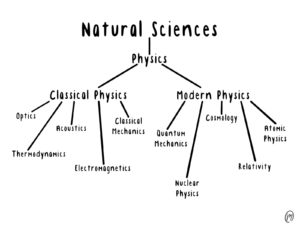Field of the Month: Physics
Field of the Month: Physics

Image credit: “Galileo’s Finger” by Katie Pitt
Welcome to the Long Island Explorium blog! Each month, the Field of the Month blogs will reflect the theme featured in STEM WonderLab, our monthly subscription box, which comes filled with a variety of at-home experiments, access to a Google Classroom so you can chat with Explorium Educators, access to a live Zoom workshop session, and infographics on different underrepresented historical figures in STEM. While the contents offered in the STEM WonderLab box are only available to those who subscribe, our blog, and the resources that accompany it, will be open to everyone!
Curious STEM explorers will be able to dive deeper into the set theme, learning about some of the major branches in each field, what scientists from that field can do, how they can begin their path towards this career, and even find additional educational resources, like interview videos featuring real-life scientists from the If/Then Collection or I am a Scientist. We hope that this space will inspire more young people to pursue a future in STEM and help those already on their educational/career paths but may feel a bit lost on what direction they want to take. Continue reading to learn about the first field that we’ll be discussing: physics!
What is Physics?
The word physics comes from the Greek word physikḗ, which means “the knowledge of nature.” Physics is the science of matter, energy, mass, and force, as well as their motion and behavior throughout space and time. It is one branch of the larger category of Natural Sciences.
What does a physicist do?
Many people who study physics will fall into one of three general roles: theoretical physicists, experimental physicists, and applied physicists. Theoretical physicists develop theories or models that can predict particular events and behaviors and explain how certain aspects of the world work; this could be in any field, from the impossibly small in the quantum world to the gigantic expanses of distant galaxies in cosmology, to anything in between! The experimental physicists then test these theories and models to determine their limits and find other approaches, if necessary. Applied physicists will then take these findings and apply them to real-world settings.
However, these are not the only jobs physicists can have. Some will use their background in physics and apply it to other areas, such as education, climate forecasting, robotics, or medicine. This is called an interdisciplinary field and will be discussed more in the Branches of Physics section.

Branches of Physics
The different areas of physics can be divided into two categories: Classical Physics and Modern Physics. This division is primarily based on when specific topics were developed; those developed before the 20th century are considered classical, while those created during the 20th century or later are considered modern. Each area of study within these two categories can be further divided into smaller, more specialized disciplines described below. Please be aware that, since physics is such a vast field, the list we have provided is not exhaustive and only includes some of the major areas of study. However, more information on these areas can be found in our Resources section.
Classical Physics:
-
- Includes any topics discovered before 1900 A.D.
- More complete when compared to modern physics, and its theories are more widely applicable to everyday life.
- Mainly concerned with Newton’s Laws of Motion, Newton’s Law of Universal Gravitation, Maxwell’s Kinetic Theory, and thermodynamics.
- Energy and matter are considered separate entities.
- Notable branches:
- Acoustics: the study of sound and sound waves, including applications for seismic waves, shock and vibration, noise, music, communication, hearing, underwater sound, and atmospheric sound.
- Optics: the study of the physical properties of light, including mirrors, lenses, and colors.
- Classical mechanics: the study of the motion of bodies in a frame of reference.
- Electromagnetics: the study of electrical and magnetic fields.
- Thermodynamics: the physics of heat.
Modern physics:
- Refers to topics developed after 1900 A.D.
- Mainly concerned with Einstein’s Theory of Relativity and Planck’s Quantum Theory.
- Explains phenomena that occur on very small and very large scales and at extremely high speeds.
- Energy and matter are considered different forms of each other.
- Notable branches:
- Relativity: the study of systems displaying characteristics of Einstein’s theory of relativity, which generally involves moving at speeds very close to the speed of light
- Quantum mechanics: the study of science where the smallest discrete values, or quanta, of matter and energy, become relevant
- Cosmology: The study of the universe as a whole, including its origins and evolution, as well as the future changes it may undergo.
- Nuclear Physics: the study of the physical properties of the atomic nucleus
- Atomic Physics: the study of atoms, specifically the electron properties of the atom (not to be confused with Nuclear Physics, which solely studies the nucleus of the atom)
It is also possible to combine two fields to create something called an interdisciplinary field, as we mentioned above. Some examples include, but are not limited to:
- Astrophysics: the study of the physical properties of objects in space
- Biophysics: the study of physics in living systems, from cells and microbes to plants, animals, and ecosystems
- Geophysics: the study of the physical properties of the Earth
- Physics Education: the study of methods currently used to teach physics; typically in high school and college
- Meteorology: the combination of atmospheric chemistry and atmospheric physics, which focuses on the processes and phenomena of the atmosphere, climate, and weather.
- Physical Oceanography: the study of physical conditions and processes within the ocean, such as the motions and physical properties of ocean water.
How do I become a physicist?
So you want to study physics. That’s great! Here, we’ve provided some information on a few attributes that can be beneficial to those looking to enter this field, as well as a general education outline. However, it’s important to remember that there is no right or wrong way to become a physicist, nor is there just one path that works for everyone. People learn and succeed through different methods and at different paces, and that’s perfectly alright. Additionally, if you find that you may not have all of the skills listed below, that’s fine too! No one is born with these skills; they are learned and improved upon over many years.
Beneficial skills, abilities, and traits:
- Analytics and problem-solving
- Mathematics and computing
- Enthusiasm for research
- Communication; Ability to visualize and explain concepts and ideas clearly
- Ability to work well independently and as part of a team
Education:
- Generally, in the United States, those hoping to become physicists will need to obtain at least a Master’s Degree in physics or a related field (i.e., engineering, material sciences, mathematics, etc.). However, a PhD is preferred
- Many entry-level positions will only require a Bachelor’s Degree
- Teaching high school and community college requires at least a Master’s Degree
- Teaching university requires a PhD
- About 4-6 years of related work experience is necessary
- Young people hoping to get a head start on gaining experience can look for camps, clubs, programs, and volunteer opportunities through local universities and organizations
Terms
Matter: any substance that has mass and occupies space.
Energy: the capacity of a physical system to perform work.
Mass: the amount of matter in an object; when on Earth, the mass of an object is the same as its weight.
Force: a push or pull upon an object; can cause an object to slow down, remain in motion, or change shape.
Natural Sciences: a branch of science that deals with the physical world (i.e., physics, chemistry, geology, biology).
Theory: a plausible or scientifically acceptable general principle, or body or principles, offered to explain phenomena.
Model: a representation of an idea, object, process, or system used to describe and explain phenomena that cannot be experienced directly.
Interdisciplinary Field: relating to more than one branch of knowledge.
Newton’s Laws of Motion: created by Isaac Newton in 1686, describes the relationship between an object’s motion and the force acting upon it.
- First Law (Law of Inertia): An object at rest will stay at rest, and an object in motion will remain in motion unless acted on by an external force
- Second Law (Force = Mass x Acceleration): the greater the object’s mass, the more force is required to accelerate the object.
- Third Law (Action = Reaction): every action has an equal and opposite reaction.
Newton’s Law of Universal Gravitation: created by Isaac Newton in 1687; a mathematical formula that describes the force of gravitational attraction between two bodies, in relation to their mass and distance.
Maxwell’s Kinetic Theory: created by James Clerk Maxwell in 1859; model that describes the thermodynamic behavior of gases.
Einstein’s Theory of Relativity: created by Albert Einstein in the early 1900’s, encompasses two interrelated concepts that apply to specific cosmological and astronomical phenomena.
- Special Relativity: theory of the structure of spacetime; describes what happens when the speed of an object approaches the speed of light.
- General Relativity: theory of gravitation; concerns the warping of spacetime due to the gravitational fields of massive bodies, like stars and planets.
Planck’s Quantum Theory: created by Max Planck in 1900; hypothesized that the energy of light is proportional to its frequency, and the constant that relates them is known as Planck’s constant (h).
Phenomena: an observable, rare, or significant fact or event.
If you’d like to learn more about physics and the historical figures who shaped this field, as well as conduct your own experiments, please consider subscribing to our STEM WonderLab subscription box. Free resources are also included below for those who are unable to subscribe.
Physics Resources
Today’s Physicists from Around the World:
- CienciaPR, Latinx Scientist Profiles (available in both Spanish and English)
- Dr. Héctor Acre, Astrophysicist and Radio Astronomer: https://www.cienciapr.org/en/monthly-story/eyes-towards-sky-puerto-rico-yale-and-back-again
- Dr. Jonathan Friedman, Atmospheric Physicist and Director of the Puerto Rico Photonics Institute: https://www.cienciapr.org/en/monthly-story/illuminating-science-promoting-field-photonics-puerto-rico
- Dr. Mayda Velasco, Physicist and Founder/Director of the Colegia de Física Fundamental e Interdisciplinaria de las Américas: https://www.cienciapr.org/en/monthly-story/dr-mayda-velasco-bringing-universe-home
- If/Then Collection, Physics Ambassadors
- Dr. Jessica Esquivel, Particle Physicist: https://ifthen.widen.net/view/video/7od0ey1cyb/EPK_Ad-Council_Jessica-Esquivel_Video-1_TK_v2?x.share=true&x.portal_shortcode_generated=9ymlrpce&x.app=portals
- Jess Fagerstrom, Medical Physicist: https://ifthen.widen.net/view/video/hqgrnlpklt/Jess-Fagerstrom_EPK-Seattle_Video-1_TK_v1?x.share=true&x.portal_shortcode_generated=9ymlrpce&x.app=portals
- Burçin Mutlu-Pakdil, Astrophysicist: https://ifthen.widen.net/view/video/jdhyhm0yxp/IfThenSummit_Burcin-Mutlu-Pakdil_Video-1_TK_v2?x.share=true&x.portal_shortcode_generated=9ymlrpce&x.app=portals
- Ciara Sivels, Nuclear Engineer: https://ifthen.widen.net/view/video/p89evzxi29/IfThenSummit_Ciara-Sivels_Video-1_TK_v3?x.share=true&x.portal_shortcode_generated=9ymlrpce&x.app=portals
- Portray Her, Profiles of Women Working in STEM
- Dr. Erin Macdonald, Astrophysicist and Science Fiction Consultant: https://seejane.org/profile/erin-macdonald/
- Dr. Amy Winebarger, Solar Astrophysicist and Rocket Scientist: https://seejane.org/profile/amy-winebarger/
Physics Learning Resources:
- Minute Physics/MinutoDeFisica, educational Youtube channel: https://www.youtube.com/user/minutephysics https://www.youtube.com/user/minutodefisica (Spanish)
- Physics Girl, educational Youtube channel: https://www.youtube.com/c/physicsgirl/videos
Additional STEM Resources
STEM Organizations:
- 500 Women Scientists, stories from diverse women scientists: https://500womenscientists.org/
- 500 Queer Scientists, stories from Queer scientists: https://500queerscientists.com/
-
- Black Girls Code, creating a space for Women of Color in STEM: https://www.blackgirlscode.com/
- I am a Scientist, stories from a wide range of scientists: https://www.iamascientist.info/
- Letters to a Pre-Scientist, year-long pen pal program: https://www.prescientist.org/donate/
- Science News for Students, online publication: https://www.sciencenewsforstudents.org/
- Skype a Scientist, connecting scientists with teachers, classrooms, groups, and the general public: https://www.skypeascientist.com/
STEM Learning Resources:
- Ask Dr. Universe, Q&A resource and podcast: https://askdruniverse.wsu.edu/
-
- Background to Breakthrough, collection of short films on Scientists of Color: https://www.youtube.com/playlist?list=PLENwi7txclRBmjSHRR28yJbO2mXWKKT2S
- Mission Unstoppable, educational Youtube channel: https://www.youtube.com/channel/UCtgUyLVqgkbkVgVZTHMkECQ
-
- Portray Her, The “Scully Effect”: I Want to Believe…in STEM: https://seejane.org/wp-content/uploads/x-files-scully-effect-report-geena-davis-institute.pdf
- Raven the Science Maven, educational videos: https://www.scimaven.com/videos
- SciShow Kids, educational Youtube channel: https://www.youtube.com/c/scishowkids/featured
- The Fab Lab with Crazy Aunt Lindsey, educational Youtube channel: https://www.youtube.com/c/TheFabLabHQ/featured
